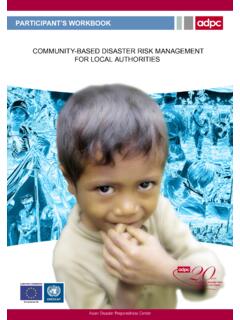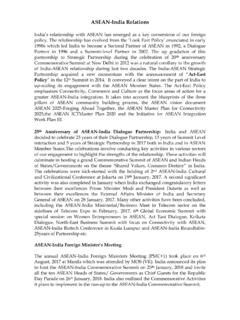Transcription of Indigenous Peoples in the Philippines - IAPAD
1 Indigenous Peoples in the Philippines A Country Case Study By: David E. De Vera Executive Director, PAFID Presented at the RNIP Regional Assembly Hanoi, vietnam August 20-26, 2007 I. The Indigenous Peoples in the Philippines : A Background The Philippines has a total land area of 30 Million Hectares. Half of the country is hilly and mostly categorized as a Forest Zone and part of the Public Domain. As of the year 2005, the country has a population of 85 Million. There are 112 ethnolinguistic groups in the country who comprise nearly 15% of the total population of the country.
2 The Philippines is slowly losing its forest cover and has to cope with an influx of mining activities in the Furthermore, demand for land and natural resources continue to rise with the unabated migration of lowland families into the mountains. Thus there exists a very volatile mix of stakeholders who are in a very strict competition for the limited resources of the uplands. A vast majority of the 12 Million population of Indigenous Peoples in the Philippines reside in the uplands which they claim as part of their traditional territories.
3 Most of the remaining natural resources in the country are found within the traditional lands of the Indigenous Peoples 1 The Philippine Government has identified mining as a priority industry Areas Identified as Ancestral Domains The Indigenous Communities: The Indigenous People represent nearly 14% of the country s population. They are among the poorest and the most disadvantaged social group in the country. Illiteracy, unemployment and incidence of poverty are much higher among them than the rest of the population.
4 IP settlements are remote, without access to basic services, and are characterized by a high incidence of morbidity, mortality and malnutrition. There are One hundred Ten (110) major Indigenous groups in the Philippines . Most of the Indigenous Peoples depend on traditional swidden agriculture utilizing available upland areas. However, most of these traditional cultivation sites and fallow areas have now been degraded and are further threatened by the influx of migrant farmers who have introduced unsustainable lowland-commercial farming practices.
5 Furthermore, most Indigenous Communities do not have legal recognition over their traditional lands, thus limiting their ability to freely conduct their livelihood activities and are denied access to other natural resources in their communities. II. Recent national policy and developments on Indigenous Peoples In recent years, the Philippine Government has made major policy reforms in order to address the serious problem of the lack of tenurial security among IPs and local communities. The Philippines has led the way in the SEA region as it had pioneered the use of long-term stewardship agreements as a tenurial instrument to recognize the resource management rights of IPs within forestlands in the early 1980s.
6 But perhaps the most radical policy reform with regards to Tenurial Security of Indigenous Peoples in the region was the enactment of the Indigenous People Rights Act (IPRA) by the Philippine Government in 1997. The IPRA goes beyond the contract-based resource management agreements between the state and the community as it recognizes the ownership of the Indigenous Community over their traditional territories which include land, bodies of water and all other natural resources therein.
7 Furthermore, the IPRA provides tenurial security to the community with issuance of an ownership Title (Certificate of Ancestral Domain/Land Title) to the concerned Indigenous clan or community. With the passage of IPRA in 1997, the law recognized the rights of Indigenous Peoples over their ancestral domains and provided for a process of titling of lands through the issuance of Certificates of Ancestral Domain Titles (CADT). The law gave jurisdiction of all ancestral domain claims to the National Commission on Indigenous Peoples (NCIP) including those previously awarded by the DENR and all future claims that shall be filed.
8 The new law provided the basis for filing new claims which included the submission of a valid perimeter map, evidences and proofs, and the accomplishment of an Ancestral Domain Sustainable Protection Plan (ADSPP). All existing ancestral domain claims previously recognized through the issuance of CADCs are required to pass through a process of affirmation for titling. IPRA included "Self Delineation" as the guiding principle in the in the identification of AD claims.
9 However, due to the lack of resources and skills in the NCIP, the Government has not been able to provide the necessary services to the IP sector to realize this mandate and issue the necessary titles. The new Arroyo administration through the National Commission on Indigenous Peoples (NCIP) has committed to fully implement the IPRA and has promised to issue at least 100 domain titles by mid-2002. However, the current budgetary allocation for the NCIP and its ancestral domain management activities remain at a paltry.
10 07% of the national budget. More ominously the situation is not expected to improve as the trend in budgetary allocation for Government services towards ancestral domain allocation including community resources management continues to decrease. 2 In its first 3 years of existence the NCIP was not able to issue a single CADT, rather it certified community consent for dozens of mining applications, an act which it had no legal power to effect under the IPRA. Initial findings of the Office of the President s Performance Audit of the NCIP reveal that the agency is ill equipped, the staff poorly trained and lacking field experience or appropriate cultural sensitivity to handle land conflicts and issues of resource access affecting Indigenous communities.


